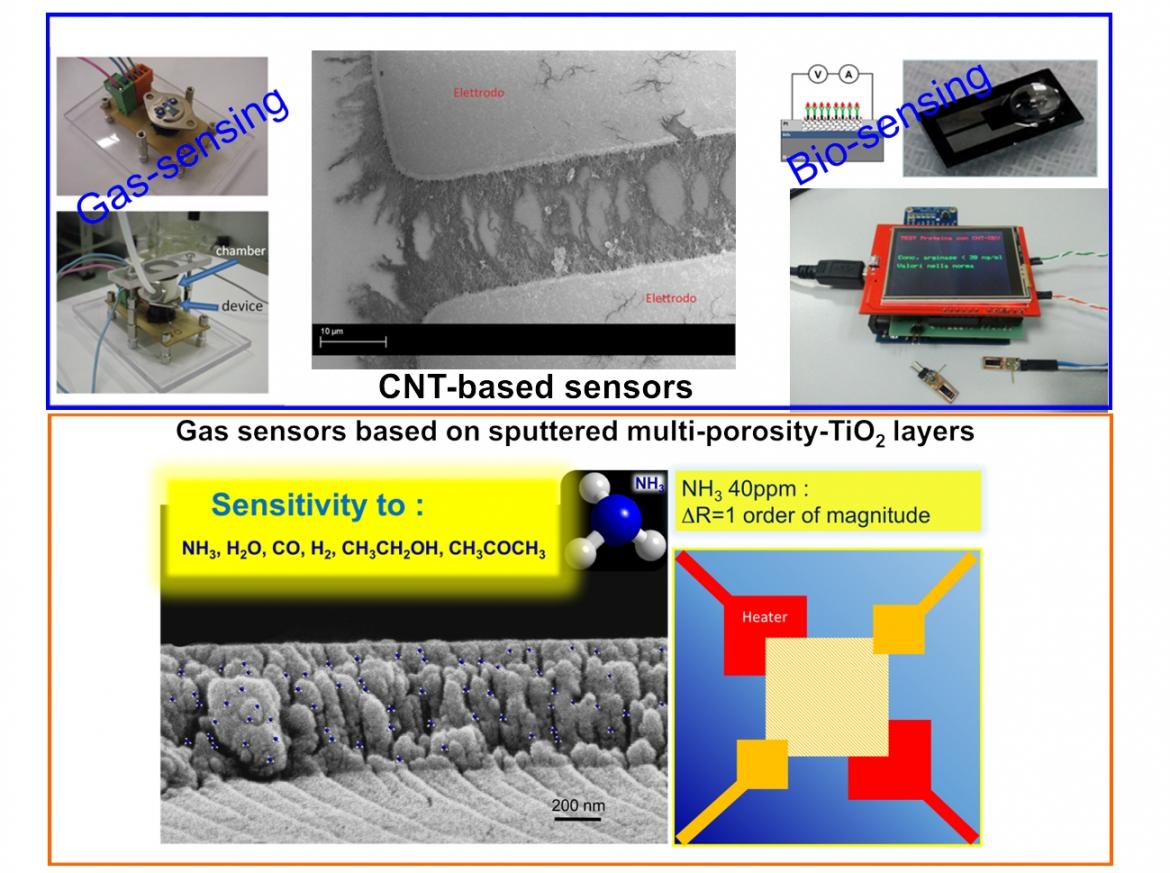
Carbon-based nanostructures and porous metal oxides are investigated as sensitive layers for the fabrication of electrical sensors for environmental and biological applications. Furthermore, an activity related to the design and fabrication of devices dedicated to the electromagnetic manipulation of human cells for health applications is in progress.
1. Sensing devices based on Carbon-nanomaterials
(Contact person: Silvia Scalese)
Carbon nanostructures can be used as the active layer of chemical, physical and biological sensors with high sensitivity and specificity, due to their high aspect ratio and the possibility to be suitably functionalized.
Our approach in this field involves, besides the use of innovative graphene-based materials, also the definition and optimization of low-cost processes, leading to the production of sensors on a large scale. The processes we propose include the deposition of C-nanostructures, such as nanotubes (CNTs), graphene oxide and reduced graphene oxide, by electrophoresis and dielectrophoresis at room temperature. Therefore, the use of low-cost (e.g.: plastic) substrates become possible and disposable sensors can be produced, as biomedical applications usually require. CNT-FET and CNT-resistor devices have been completely produced and characterized at IMM from both morphological and electrical point of view, and can be used for gas [ref.1] and biosensing [ref.2]. Further work is in progress using other graphene-based materials instead of carbon nanotubes as sensitive layer.
Fig.1: (a) Scheme of the DEP system and geometrical features of the device; (b) SEM image of the CNT film region between the electrodes in the sensing device.
2. Sputtered multi-porosity-TiO2 layers for gas sensing
(Contact person: Alessandra Alberti)
Multi-porosity-TiO2 layers are grown at the Catania Headquarters by modified grazing incidence reactive sputtering methodology form a pure Ti source, using Ar as sputtering species and O2 as reactive gas. With respect to chemical approaches, able to generate hierarchical or porous structures with high infiltration capability, the use of sputtering methodologies to grow porous TiO2 thick layers represents a challenge. It would actually offer huge advantages in terms of reproducibility, purity, up-scalability of the deposited layers, mostly impacting on the cost of the final commercial products. Our modified sputtering methodology achieves all those breakthroughs as it allows getting and tuning high porosity levels at low deposition temperature (T<200°C). Our multi-porosity TiO2 architecture has been implemented in gas sensors for NH3,H2,CO, acetone and ethanol detection. The TiO2 layer sensitivity in relationship with the different species, the exposed surface area, the lattice structure of the matrix and the operation temperature is under investigation.
Fig.2
3. Electromagnetic manipulation of human cells for health applications
(Contact persons: Silvia Scalese, Antonino la Magna)
Another methodology that is under investigation is the manipulation by electromagnetic fields of human cells or sub-cell components. This study can find application in the sorting of tumoral cells from a solution containing a mixture of healthy and cancer cells, with the possibility to concentrate the second ones that often with conventional methods are hardly observable due to low concentration in the serum. The method is based on the different dielctrophoretic response of the two cellular lines to oscillating electro-magnetic field generated by electrodes in micro-fluidic devices. Design of the full device (both the microfluidic and the electrical parts) is aided by computer simulations of the system operative behavior.
Fig.3: Dielectrophoretic manipulation of MDA-MB-231 (breast cancer triple negative) cells.


